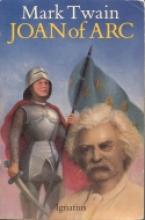No name
Joan of Arc
While I used Mark Twain's Joan of Arc as a read-aloud, I used Poole's version for the younger children. Also, the pictures and map really complimented Twain's book.
Joan of Arc
So who is qualified to tell this story? Another saint? A theologian? A soldier? What about just a good American story-teller -- indeed the best -- but a man with hardly any faith at all?
Mark Twain is most famous for his Mississippi River stories, Tom Sawyer and Huckleberry Finn. It is not well enough known that his own favorite of all his works was the life of St. Joan of Arc, told from the fictional perspective (but this is the only fiction in the book) of a childhood companion who accompanied her on her wars, and then smuggled himself into her trials as a court reporter and was the last to touch her hand before she died.
Mark Twain really loved Joan and he dedicated the entire fiber of his wonderful talent to telling her story. I see him in the year 1910, knocking at the Pearly Gates, and I see Peter's hesitation, for Twain was after all, something of an unbelieving old cynic. But over Peter's shoulder, I see a slight and mischievous lass tugging his sleeve and saying with a grin, "Let him in, now, let him in!" while a Voice thunders from the Throne, "Any friend of Joan's is a friend of Mine."
Read it yourself, silently or aloud to the family, and see if you don't agree.
John Treegate's Musket
Jonah and His Amazing Voyage (Bible Adventure Club)
Set sail on a stormy sea with Jonah and His Amazing Voyage as your young children learn about Bible stories in this light-hearted set from the Bible Adventure Club series.
Each kit includes a hard cover full-color picture story book, activity book, read-along audio cassette, interactive CD-Rom, and parents guide. The picture book is a simple retelling of the story of Jonah to appeal to younger children with bold, colorful, and cartoon-like illustrations. The audio cassette is a dramatized version of the story with original music to listen to while reading along with the book. The activity book includes fun facts, projects, mazes, and more. The interactive CD-Rom includes an animated story, original song, coloring book, word search, matching, puzzles, quiz game and light up puzzle (a scrambled puzzle that lights up when the squares are in order.). Some activities offer different levels of play.
Because of the light-hearted approach and the types of activities, this kit is designed for younger children. My five-year-old and eight-year-old daughters have enjoyed listening to the story many times as well as playing the many creative learning activities on the CD-Rom. Since there are a variety of activities on the CD-Rom and in the activity book, a wide range of younger children can enjoy this kit. Jonah and His Amazing Voyage is just one from a series of Bible Adventure Club kits. Other kits include Other kits include Creation:God's Wonderful Gift, Jesus:the Birthday of the King, Noah and the Incredible Flood, and David and his Giant Battle.
Joseph and Chico, The Life of Pope Benedict XVI as Told by a Cat
Journey into Amazing Caves
Julie of the Wolves
The book is divided into three parts - the first part, Amaroq the Wolf, tells in intense anthropological detail how 13 year old Miyax strives to study and become accepted by the wolf pack so she can have a share of their kills. The tone is completely unsentimental but infused with the fervent admiration and affection Miyax feels for these fellow travelers.
The second part is a flashback recounting how Miyax was raised by her father in an Eskimo seal camp until the age of nine, when she had to live with her aunt in order to go to school. In order to escape from this life, she was willing to cooperate in the traditional child-marriage her father had arranged between her and a son of a friend in Barrow. Violence on the part of the young husband drives her into the wild; her goal is to reach a port town and sail to meet her pen pal Amy, who lives in San Francisco.
The third part tells of how her dreams of American civilization, symbolized by her friend Amy's pink room, are shattered by a new act of violence; this time against the wolf she has come to think of as a father. Is American civilization really so civilized after all? The final decision she has to make does not fall along simple black-and-white lines, just as the real-life balance between traditional and modern civilization is not an easy one for today's Eskimos to come to terms with.
This book is a difficult one to review in some ways. Miyax's character is beautifully drawn, and the wolves and the stunning Alaskan environment qualify as characters in their own right in this book. Miyax is so distinctively Eskimo, composing songs to the wolves and skinning caribou with her ulu, and yet so universally a young girl. I can picture some children loving this book and others being put off just because it is so unique.
There is nothing wrong with the morality presented in the story that I could find. Miyax strives to maintain her integrity throughout the book in the face of many difficulties. Yet the scene when her young, mentally disabled husband tries to force himself on her might be too much for young readers. It has a pivotal part in the story; it is not dwelt on inappropriately. I think I would give this to an older reader, perhaps a high schooler; with a younger child, you might want to pre-read the troubling section and perhaps discuss it beforehand.
This book has been recommended by some for our red flag list because of the troubling section mentioned in the review.
Just David
One day he and his father pack their belongings and head back toward civilization. The father, deathly ill, dies on the journey and David finds himself in the care of a well-meaning elderly farm couple. They and most of their neighbors have a very difficult time understanding the golden-hearted David, who makes friends with the lonely and forgotten of the town and soothes many hardened hearts with his beautiful music. David becomes wrapped up in a fairy tale and a mystery which figure heavily in the plot.
Parents may see this story as an embodiment of some of the most fundamental ideas of the homeschool movement. Some will no doubt find it a little sappy. It might make an interesting contrast to the book North to Freedom by Anne Holm, whose character, also called David and of approximately the same age, makes a transition from the evils of a prison camp into a much more beautiful world.
Just Jennifer
Jennifer and Peter 's mother died when Jennifer was only five. Their father remarried a delightful and kind new mother, who loved them very much. With her came Gwen and Alice, who Jennifer said could only be "half army" (since they weren't born on an Army Post). Then came the twins, Neal and Susan, and Bitsy, who were all declared "definitely army" by Jennifer. Sadly, this mother also died leaving Jennifer in charge.
Right before Gen. Jordon had to leave on overseas duty, a telegram arrived notifying them that Gen. Jordon's brother and wife had died and their son, Donny, had to go live with the Jordons! So, Donny slipped in quietly between Alice and the twins, and since he was a quiet boy, it seemed as if he had been there forever.
Read, also, in this great book how the Jordons moved (under the guidance of a 16 yr. old!) to a nearby lake, adopted a dog, got a horse, encouraged a romance, and befriended a lonely English boy. This was a very good book that I enjoyed immensely.
Reviewer 8th grade homeschooler






